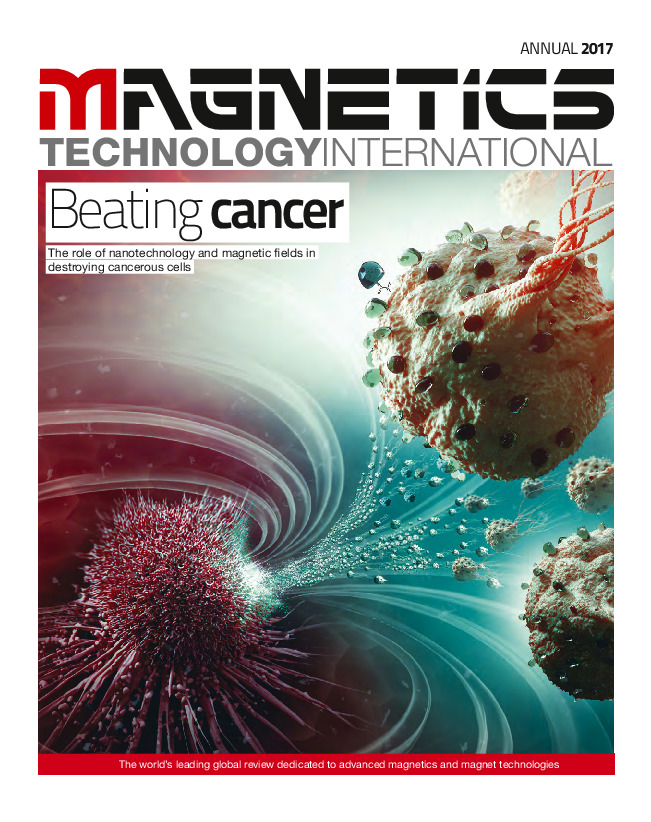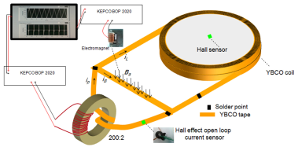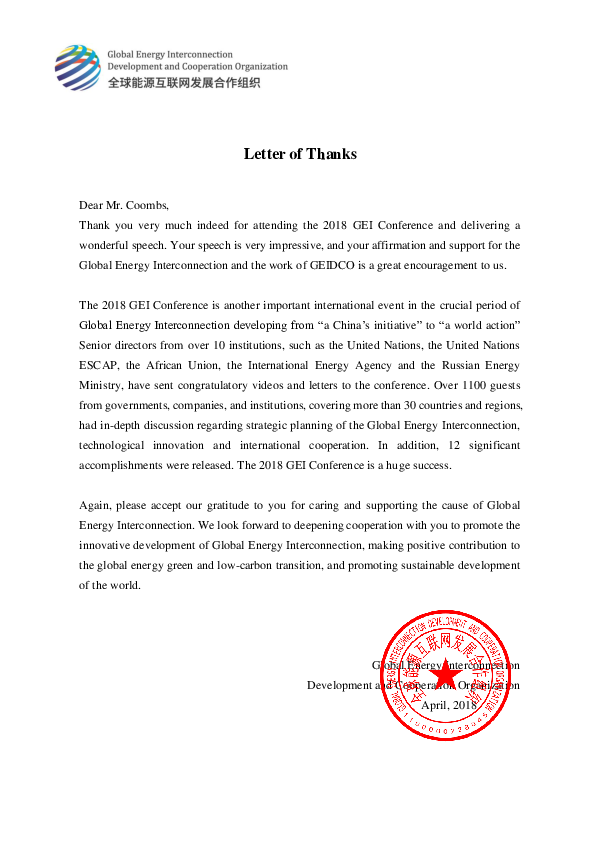
Flux pumps for HTS coils
Flux pumps are becoming a promising method of injecting flux into closed High-T c
superconducting magnets without electrical contact
Thanks to progress in manufacturing long-
length coated conductors (CCs), CC coils
are becoming increasingly popular for
magnets. CC coils have much better
mechanical properties compared with High-T c
superconducting (HTS) bulks and have satisfactory
current density. CC coils are also more flexible
than tape stacks. These merits make CC coils
ideal for high-field magnet uses, as in an MRI/NMR
insert coil. In these applications it is desirable to
operate CC coil magnets in persistent current
mode, in which case thick current lead and
associated heat losses can be avoided. However,
flux leakage is inevitable in closed CC coils. This is
because, although HTS joints with extremely low
resistance have been developed, flux creep in CC
coils is non-negligible especially when the
transport current is close to the critical current and
the operating temperature is high. Furthermore,
when CC coils are under an external AC field, loss
is induced, which makes the direct current decay
much more evident. Recently HTS flux pumps
have been developed to compensate for the
current decay in CC coils, which makes it possible
for CC coils to work in persistent current mode.

Ultrasound scanning enhancements.
What are Lorentz force electrical impedance tomography and high-temperature superconductors
and how can they improve medical imaging? New YBCO-coated conductors, commonly known as 2G tapes, have the potential, when combined with a simple imaging technique such as Lorentz force electrical impedance tomography (LFEIT), to revolutionize medical imaging. The technique, which uses a magnetic field together with an ultrasound source, could enhance the already familiar method of ultrasound scanning while not requiring the exacting standards (magnitude and uniformity of field) demanded by MRI.
YBCO-coated conductors can carry very high currents in a very small form factor. A 12mm-wide tape, 100µm thick, can typically carry 350A at 77K (the boiling point of nitrogen). Therefore we have the potential to produce ultra-light, ultra-compact magnets, simply cooled in a bath of liquid nitrogen, which when used together with the LFEIT
technique can provide a means of rapid diagnosis and therefore effective treatment.
Scientists at the University of Cambridge have designed a new battery that clears the path towards long-lasting, efficient rechargeable devices, from cars to smartphones. The breakthrough comes in the shape of a lithium-air cell - a concept that can pack in much more energy per kg than current lithium-ion batteries. But until now, problems of efficiency and degradation have plagued efforts to build such batteries.
Continue Reading →
High-Tc Superconducting (HTS) magnets operating in persistent current mode suffer a current decay due to flux creep of superconductor and joint resistance. Flux pumps are able to inject direct current into superconducting circuit to compensate the current decay, without the thermal loss caused by current leads. In this work, we proposed a flux pumping mechanism for HTS coils, with an experimental verification and an analytical model. The basic principle we have used is that flux flow can be triggered when the superconductor carrying a direct current is subjected to a perpendicular AC magnetic field. Low frequency alternating current is induced in a loop of YBCO tape using an AC field. A portion of the tape which we refer to as the “bridge” shorts a superconducting coil. A high frequency AC field is applied perpendicular to the bridge tape when alternating current in the tape reaches one polarity. This triggers a net flux flow and results in a current increase in the coil. The proposed flux pump has clear physics and is easily controllable, which may make it promising in practical use.
Continue Reading →
A new record for a trapped field in a superconductor, beating a record that has stood for more than a decade, could herald the arrival of materials in a broad range of fields.
A world record that has stood for more than a decade has been broken by a team of engineers led by Professor David Cardwell, harnessing the equivalent of three tonnes of force inside a golf ball-sized sample of material that is normally as brittle as fine china.
Professor Cardwell’s team managed to ‘trap’ a magnetic field with a strength of 17.6 Tesla - roughly 100 times stronger than the field generated by a typical fridge magnet - in a high temperature gadolinium barium copper oxide (GdBCO) superconductor, beating the previous record by 0.4 Tesla. The results are published today in the journal Superconductor Science and Technology.
Clean and Cool Mission Colorado is an entrepreneur mission to help 20 of the UK’s most promising early stage and innovative cleantech SMEs do business in the US faster
The Mission will help winning companies: develop quality contacts with investors and partners, gain unique insight, profit from fresh stimulus, and improve pitch and profile.

Lunch at the National Renewable Energy Laboratory’s (NREL) Industry Growth Forum, excellent food, excellent company and yet another opportunity to pitch! The last two days of the Clean and Cool Mission to Colorado have been hectic, fulfilling, exhausting and exhilarating all at the same time. Today it got serious as we went from practice to implementation. Talking to real people – people who might just be the ones who will turn this trip from a worthwhile trip into a trip of lifetime. Did I meet anyone like that? The truth is I don’t yet know. I see this trip as a seed planting exercise. I am sure it will bear fruit and will bear fruit soon but I am too busy seed planting at the moment......
Continue Reading →
For most people, their experience of magnets is limited to their ability to attach shopping lists to the fridge. But the industrial cousin of the humble fridge magnet is a near ubiquitous presence in countless technologies, ranging from ship propulsion systems to bus engines and medical devices to the turbines that feature in virtually every form of energy generation.
But now a spin-out from Cambridge University reckons it has developed a new form of superconducting permanent magnet that promises to replace these critical industrial magnets with a new material that is 10 times stronger.
"The technology is a game changer," predicts Magnifye\'s founder and head of the electrical power and energy conversion superconductivity group at Cambridge University, Dr Tim Coombs. "It was a piece of physics that had been overlooked and that has allowed us to come up with a technology that a lot of people need. We can massively increase efficiency, but we can also do things that couldn\'t be done before. It is a platform technology, but it is also an enabling technology and a disruptive technology."
Quite how disruptive remains to be seen, but Coombs is confident the technology could have numerous applications, including a major role to play in the clean tech sector.
Welcome aboard
Clean and Cool Mission Colorado is an entrepreneur mission to help 20 of the UK’s most promising early stage and innovative cleantech SMEs do business in the US faster
The Mission will help winning companies: develop quality contacts with investors and partners, gain unique insight, profit from fresh stimulus, and improve pitch and profile.

A group of the UK’s most promising clean technology companies have been chosen to attend the Clean and Cool Mission to Colorado in December. The sixteen companies, which were recently unveiled at an official ceremony in London, will visit Colorado, the fastest-growing cleantech ecosystem in the U.S, to showcase their innovations and explore business opportunities associated with tackling climate change.
........
Looking to expand in the US, where the renewable energy program is rapidly expanding and looking for solutions that can support its own renewable energy targets, Wind Power Performance want to scale up awareness of its technology on the Mission.
Magnifye superconducting permanent magnets can be used to improve the efficiency of any electrical machine. Ten-times stronger than conventional magnets, they are small enough to fit into the palm of the hand and large enough to power a train or a cruise liner. With almost limitless applications, Magnifye could transform the way the world powers electrical machines.
Unveiled: UK firms selected for innovation mission to U.S. cleantech capital
A group of the UK’s most promising clean technology companies have been chosen to attend the Clean and Cool Mission to Colorado in December. The sixteen companies, which were unveiled at an official ceremony in London last night, will visit Colorado, the fastest-growing cleantech ecosystem in the U.S, to showcase their innovations and explore business opportunities associated with tackling climate change.
The week-long Clean and Cool Mission to Colorado, organised by the UK’s innovation agency, The Technology Strategy Board, together with The Long Run Venture and UK Trade and Investment, will see the sixteen UK cleantech companies learn from key leaders in the field and network with potential investors in Boulder, Denver and Fort Collins – they will participate in the National Renewable Energy Laboratory’s (NREL) Industry Growth Forum, the premier clean energy investment event in the U.S.
As the number one U.S market for renewable energy and second best state for entrepreneurship and innovation, the Mission to Colorado will enable participants to learn first-hand how to accelerate their business in the important U.S market.
Among the delegation are companies whose innovations address some of the most pressing climate challenges in the country and worldwide, including increasing transport pollution, improving energy efficiency in residential homes and easing reliance on peak grid supply.
Discussing the Mission, David Bott, Director of Innovation Programmes at the Technology Strategy Board, said: “The U.S has one of the most innovative and dynamic cleantech ecosystems. The Mission will provide the participants with the opportunity to establish partnerships, secure investment and help launch their business to a large, continually expanding and thriving technology market.”
Simon Carter, Deputy Director, Head of Renewable Energy at UKTI, explained: “We are delighted to sponsor the Clean and Cool Mission to Colorado and support UK innovation internationally. Colorado is a fast and reliable gateway to the U.S and to global markets and the Mission will allow the firms to learn how to turn their innovations into tangible business opportunities.”
Taking place 30th November – 6th December, the sixteen companies will have an opportunity to extend their international operations in sectors ranging from solar and wind, smart grids, energy storage, system integration, to smart buildings and transport.
This year’s first brainstorm took place at the top of the Heron Tower in London; the view over the city combined with the light bulb decoration helped spark some creative thinking and a thoroughly enjoyable evening.
As soon as the brainstorm started heads were bowed around the room and a huge range of solutions, from automated adjustment of generators to apps utilising open data, were suggested.
Many tables talked around general themes such as freedom of information and the need for informed consumers, while some, like Table 11, recognized the paradox of increasing reliance on IT solutions while at the same time trying to avoid an increase in emissions from the computer sector.
Several tables discussed the pros and cons of some sort of carbon initiative. Dr Tim Coombs (University of Cambridge) of Table 11 suggested that consumer awareness combined with dynamic carbon pricing would help create ‘smart individuals’ and‘intelligent energy storage systems.’
Tables 1 and 6 both felt that connected societies were an element of the solution.Fiona Harvey from The Guardian argued that energy literate citizens in ‘Smart Communities’ might work together to reduce emissions, while Elaine Weidman-Grunewald from Ericsson (and Table 1) thought that the networked society would lead to system-wide optimization.
The vote was tight, with most tables falling within a point of each other. Lucky number 7 won out for Table 7 that gave us a 7 step solution - starting with an‘Energy Wikileaks’ and ending with governments mandating the use of networked devices for an ‘internet of things.’
Tim and other key figures from the Cambridge business community gathered at TWI, Granta Park, on Monday 18th March for a breakfast event to mark the launch of Cambridge Business Week – a celebration of success in technology and innovation with a focus on the achievements and market-leading strengths of local companies.
TWI hosted the launch on behalf of the Cambridge Business Week organising committee, and welcomed the Secretary of State for Business, Innovation and Skills, the Rt Hon Dr Vince Cable MP, Cambridge MP Dr Julian Huppert and local figurehead Dr David Cleevely CBE to its laboratories to meet with entrepreneurs and business leaders and to share in the outstanding accomplishments of the Cambridge Cluster.
This paper describes the behaviour of bulk superconductors when subjected to a varying magnetic field. A magnetic model is described together with experimental results which explain and describe the behaviour of superconducting bulks when subjected to varying magnetic fields. We demonstrate how the behaviour is dependent on the magnitude and period of the perturbations in the fields. The model which we use has been implemented using the Comsol™ pde solver. It is a fully integrated model which uses a variable heat source to regulate the magnetic circuit and thereby to achieve flux pumping. Comsol™ is used for post solution visualization and the model is presented alongside experimental results which support and confirm the conclusions from the model.
Continue Reading →
Dr Coombs speaks to the Oxford University Engineering Society

Dr. Tim Coombs is Director of Magnifye Ltd., and a Senior Lecturer in Cambridge University’s Engineering Department. Twenty years of experience in superconductivity have given Dr Coombs a unique perspective on the electric power generation and distribution problem, as well as (potentially, at least) part of the solution. In his talk, Dr Coombs will highlight the problems and the role which superconductors (and especially superstrong superconducting magnets) can take in providing a solution.
Continue Reading →
The development of bulk high-temperature superconducting magnets opens up possibilities for a huge range of industrial and medical applications. A bulk superconductor is one where the superconductor has been processed to produce a square, round or hexagonal cross-section lump typically 2-6cm across and 1cm deep. In appearance it is very similar to a conventional permanent magnet. Bulk superconductors are particularly important because they can provide very high magnetic fields in a very compact package and are effectively ‘supermagnets’.
Continue Reading →
Magnifye, Cambridge U Develop All-Superconducting Motor
Potential Uses for Motor in Transportation, Wind Power
Greater Energy Savings at Lower Motor Speeds
Greater Magnetization Possible with Rare Earth Superconductors
Heat Engine Creates Stable Magnetic Field

Over 150 British companies, further education institutions and other organisations are set to share around £18 million of government investment that will support innovation and growth in a number of important technology areas.
Magnifye in conjunction with Rolls Royce, EADS and the university of Cambridge have been succesful in obtaining funding as part of a major new program which has just been announced by the Technology Strategy Board.

Magnifye Limited in Cambridge – working in conjunction with the university’s EPEC Superconductivity group – has created the world’s first all superconducting motor.
The motor uses superconducting permanent magnets on the rotor together with second-generation high temperature superconducting tape on the stator.

Engineers at the University of Cambridge have also used new techniques to manufacture high-temperature superconducting materials, producing samples that can carry record quantities of electrical current for their type and size. he breakthrough has improved the effectiveness of yttrium barium copper oxide (YBCO) and a related family of superconducting materials. It raises the prospect of more powerful and affordable samples that could have huge benefits in a number of fields.
Continue Reading →This Superconducting Permanent Magnet Motor has been built at Cambridge University's Engineering Department in collaboration with Magnifye Ltd.
Continue Reading →Inventor of the most powerful permanent magnet in the world and head of the superconductivity group in Cambridge
Continue Reading →
The technique uses repeated applications of weaker fields, making it possible to generate more powerful fields without an intrinsically strong magnet. The key is to create a pulse of magnetic flux that travels across the puck in a single direction, creating a consistent electric field in the material. Coombs says that other magnetisation techniques, such as repeatedly applying a uniform magnetic field, induce an electric field that is countered when the field is removed. The technique could let a 240kg magnet replace a current design weighing 3t in magnetic-resonance imaging scanners and cut the energy demand for cooling from 10GJ to 338MJ.
Continue Reading →
Weijia Yuan and Ruilin Pei took their scientific research to the House of Commons. Both students joined other early-career scientists from across the country to compete in a national scientific poster competition, SET for Britain, at the House of Commons.
Continue Reading →
The next generation of superconductors look set to revolutionise everything from medical scanners to rail networks, with its potential to enable lower energy consumption across society.
Continue Reading →A revolutionary magnet ten times stronger than normal could see MRI scanners become hand-held, and electric motors miniaturised. The process, developed at the University of Cambridge in the UK, uses a superconducting material and requires no current, simply to be super-cooled.
Continue Reading →A Cambridge scientist says he has developed a magnet strong enough to lift a truck, which could revolutionize MRI scanners and electric motors.
Continue Reading →
WHAT is claimed to be the world's strongest permanent magnet has been developed by scientists at Cambridge in the UK. Among other potential applications, it could allow smaller, less expensive and more patient-friendly MRI scanning units to be built for hospitals.
Continue Reading →
Work is progressing on several fronts to take superconductors out of the laboratory fridge into the real-world.
Continue Reading →
The University of Cambridge remains a hothouse for new science & technology enterprise and one of our latest entries for the East of England Business Awards is a brilliant example. Magnifye‘s technology has spun out of work at the department of engineering and is masterminded by Dr Tim Coombs.
Continue Reading →
Magnifye, a Cambridge University spin-out, would increase the power density of magnets used to produce energy in electric motors. The magnets, which are 10 times stronger than conventional magnets, are so powerful that a 1 inch sample could potentially support the weight of a seven-ton truck.
Continue Reading →
IF you thought magnets were just useful to hold inane messages on your fridge door, think again. This is magnets: the next generation.
Magnets feature in many everyday items - computers, televisions, cars, credit cards - but the use in many applications is limited because the magnets would have to be massive to do the job required.

Incredibly powerful magnets developed by Cambridge scientists could make a future generation of magnetic resonance imagers small and cheap enough for use in doctors’ consulting rooms.
Continue Reading →Magnifye is developing the technology to produce the strongest permanent magnets in the world with a one-inch magnet able to lift a lorry.
Continue Reading →
At the 10th Cambridge Enterprise Conference, at the end of September, a number of startups showed up to exhibit what could be the next wave of technology to penetrate our everyday lives. Magnifye Ltd was one of them.
Continue Reading →
Thermal cycling can be used to magnetise high temperature superconducting magnets to 17 Tesla, opening up applications in much more compact MRIs and large motors.
Continue Reading →
A super magnet - strong enough to lift a seven-tonne truck - is being developed by engineers at Cambridge University. The project aims to magnetise superconducting material, which can create magnets 10 times more powerful than normal.
Continue Reading →Super magnets that can lift a seven-tonne truck. These are superconducting magnets being worked on at Cambridge Universitys Department of Engineering. Theyll soon be used to reduce dramatically the size of electric motors for cars and wind turbines.
Continue Reading →
A nascent and potentially disruptive electromagnet technology forged in Cambridge laboratories with the potential to revolutionise several multi-million pound electric motor industries.
Continue Reading →
A Cambridge University spin-out has received proof of concept funding to push out a new type of magnet that could find itself rolled out across several multi-million pound industry sectors within the next two years.
Continue Reading →







